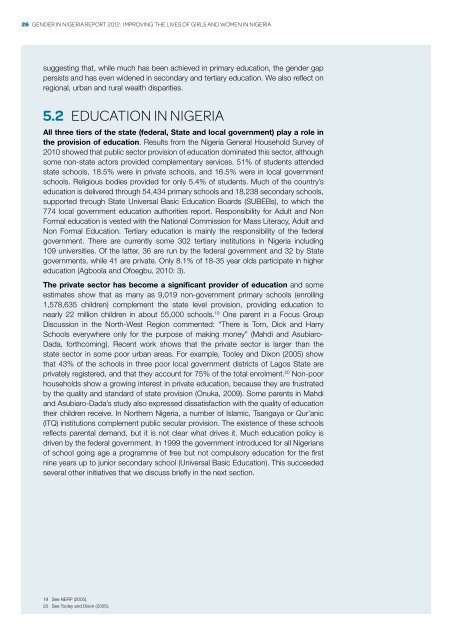Gender in niGeria report 2012 - Economic Commission for Africa
Gender in niGeria report 2012 - Economic Commission for Africa
Gender in niGeria report 2012 - Economic Commission for Africa
Create successful ePaper yourself
Turn your PDF publications into a flip-book with our unique Google optimized e-Paper software.
26 <strong>Gender</strong> <strong>in</strong> Nigeria Report <strong>2012</strong>: Improv<strong>in</strong>g the Lives of Girls and Women <strong>in</strong> Nigeria<br />
suggest<strong>in</strong>g that, while much has been achieved <strong>in</strong> primary education, the gender gap<br />
persists and has even widened <strong>in</strong> secondary and tertiary education. We also reflect on<br />
regional, urban and rural wealth disparities.<br />
5.2 Education <strong>in</strong> Nigeria<br />
All three tiers of the state (federal, State and local government) play a role <strong>in</strong><br />
the provision of education. Results from the Nigeria General Household Survey of<br />
2010 showed that public sector provision of education dom<strong>in</strong>ated this sector, although<br />
some non-state actors provided complementary services. 51% of students attended<br />
state schools, 18.5% were <strong>in</strong> private schools, and 16.5% were <strong>in</strong> local government<br />
schools. Religious bodies provided <strong>for</strong> only 5.4% of students. Much of the country’s<br />
education is delivered through 54,434 primary schools and 18,238 secondary schools,<br />
supported through State Universal Basic Education Boards (SUBEBs), to which the<br />
774 local government education authorities <strong>report</strong>. Responsibility <strong>for</strong> Adult and Non<br />
Formal education is vested with the National <strong>Commission</strong> <strong>for</strong> Mass Literacy, Adult and<br />
Non Formal Education. Tertiary education is ma<strong>in</strong>ly the responsibility of the federal<br />
government. There are currently some 302 tertiary <strong>in</strong>stitutions <strong>in</strong> Nigeria <strong>in</strong>clud<strong>in</strong>g<br />
109 universities. Of the latter, 36 are run by the federal government and 32 by State<br />
governments, while 41 are private. Only 8.1% of 18-35 year olds participate <strong>in</strong> higher<br />
education (Agboola and Ofoegbu, 2010: 3).<br />
The private sector has become a significant provider of education and some<br />
estimates show that as many as 9,019 non-government primary schools (enroll<strong>in</strong>g<br />
1,578,635 children) complement the state level provision, provid<strong>in</strong>g education to<br />
nearly 22 million children <strong>in</strong> about 55,000 schools. 19 One parent <strong>in</strong> a Focus Group<br />
Discussion <strong>in</strong> the North-West Region commented: “There is Tom, Dick and Harry<br />
Schools everywhere only <strong>for</strong> the purpose of mak<strong>in</strong>g money” (Mahdi and Asubiaro-<br />
Dada, <strong>for</strong>thcom<strong>in</strong>g). Recent work shows that the private sector is larger than the<br />
state sector <strong>in</strong> some poor urban areas. For example, Tooley and Dixon (2005) show<br />
that 43% of the schools <strong>in</strong> three poor local government districts of Lagos State are<br />
privately registered, and that they account <strong>for</strong> 75% of the total enrolment. 20 Non-poor<br />
households show a grow<strong>in</strong>g <strong>in</strong>terest <strong>in</strong> private education, because they are frustrated<br />
by the quality and standard of state provision (Onuka, 2009). Some parents <strong>in</strong> Mahdi<br />
and Asubiaro-Dada’s study also expressed dissatisfaction with the quality of education<br />
their children receive. In Northern Nigeria, a number of Islamic, Tsangaya or Qur’anic<br />
(ITQ) <strong>in</strong>stitutions complement public secular provision. The existence of these schools<br />
reflects parental demand, but it is not clear what drives it. Much education policy is<br />
driven by the federal government. In 1999 the government <strong>in</strong>troduced <strong>for</strong> all Nigerians<br />
of school go<strong>in</strong>g age a programme of free but not compulsory education <strong>for</strong> the first<br />
n<strong>in</strong>e years up to junior secondary school (Universal Basic Education). This succeeded<br />
several other <strong>in</strong>itiatives that we discuss briefly <strong>in</strong> the next section.<br />
19 See NERP (2005).<br />
20 See Tooley and Dixon (2005).

















